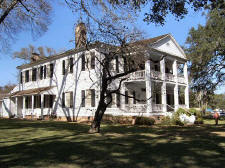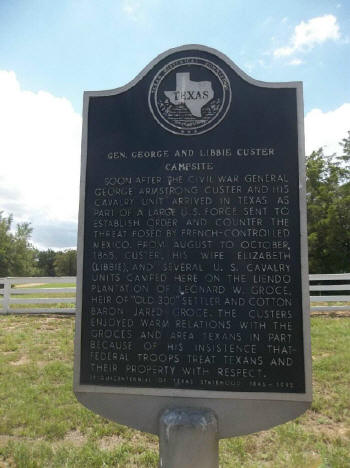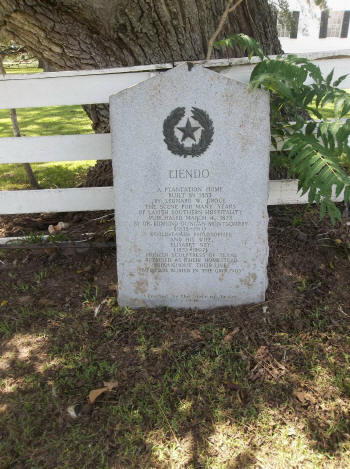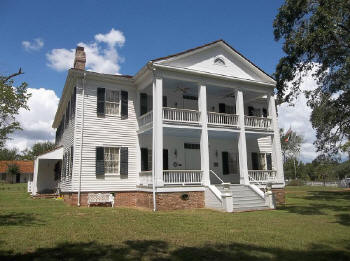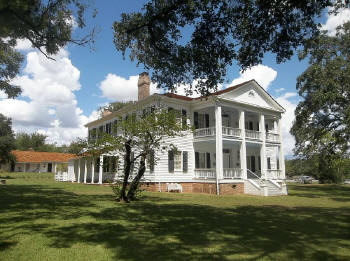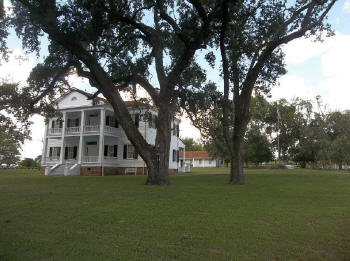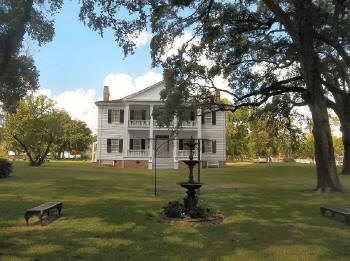|
(September 2013)
Enlarge Liendo Custer Texas
Historical Marker
This Texas historical marker is located on the roadway next to the
entrance for Liendo plantation. Although the marker is not directly
related to the Civil War, it does reflect the Union occupation during
Reconstruction.
George Armstrong Custer used the location as his cavalry base and had his
wife stay in the home. George Armstrong Custer was a dog lover so he was
very pleased to obtain hunting dogs from the owners of the plantation. Sam
Houston and other notables stayed at this location so it is fortunate the
home was not destroyed. The plantation and home are in private ownership
and the house is still used by the owner. |
|
(September 2013)
Enlarge Liendo Texas
1836-style Monument
This photo was taken September 7, 2013 during a time when the private home
was open for guided tours. The home can be seen in the background of this
photo. The text of the monument may be hard to read from the photo so
please look at the inscription below:
A plantation home built in 1853 by Leonard W. Groce. The scene for many
years of lavish Southern hospitality. Purchased March 4, 1873, by Dr.
Edmund Duncan Montgomery 1835-1911), world-famed philosopher, and his
wife, Elisabet Ney (1833-1907), pioneer sculptress of Texas. Retained as
their homestead throughout their lives. Both are buried in the grounds. |
|
(September 2013)
Enlarge Liendo Close-up
The tour guide told us during our tour on Sept 7, 2013 that Gross family
of South Carolina had some friction so one part of the family changed the
spelling of the surname to Groce and came to Texas but still pronounced
the name the same way. The home was designed to look like a plantation
home in their native state. Today the house is privately owned but
occasionally open for tours and a site for weddings. |
|
(September 2013)
Enlarge Liendo Full View
This home its buildings were used as a camp of instruction for the
Confederate Army.
Access to food, water, forage and open land made it an ideal site for
cavalry instruction, as well as instruction of other branches of the CSA
Army. Later in the war the location was used as a prisoner of war camp.
Supplies were exhausted so the camp was moved at various times, but always
not too distant from the home.
At the end of the war Confederate officers bade farewell to their troops
from near this location. |
|
(September 2013)
Enlarge Liendo Tree
1853 - named for Spanish grantee Justo Leindo, first to own this land.
Mansion built by Leonard W. Groce, who surrounded it with model plantation
industries. In Civil War, site of Camp Groce, a camp of instruction and
then P.O.W. center. Occupied in 1865 by Gen. Geo. W. Custer, later to be a
central figure in the Little Big Horn tragedy. Owned, 1873-1911, by family
of sculptress Elisabet Ney, commemorated with a marker on grounds.
Recorded Texas Historic Landmark - 1964
We were told by our tour guide that the tree in the center was dated at
500 years old. The photo also shows some out buildings and the new roof.
Peacocks roam the area, too. In the background picnic tables can be seen.
The picnic tables are near the family cemetery. Just out of view is a
gentle slope of a hill to HWY 290. |
|
(September 2013)
Enlarge Liendo POW Cemetery
Several Confederate military facilities were positioned near Hempsted (2.5
mi. w), an important railroad junction, during the Civil War. Camp Groce
was a prisoner-of-war stockade established on the plantation of Leonard
Waller Groce (1806-1873). Union Army prisoners who died at various camps
were buried hear this site on the McDade Plantation, adjacent to the
McDade family cemetery The cemeteries were near a narrow gauge spur off
the "Austin Branch" of the Houston & Texas Central Railroad, built from
Houston in 1858. A yellow fever epidemic in 1864 resulted in many deaths
at Camp Groce and other camps, chronicled by Aaron T. Sutton (1841-1927).
a Union prisoner in Company B, 83rd Ohio Volunteer Infantry. Sutton noted
in his journal the presence of more than 100 fresh graves here soon after
his arrival at Camp Groce in 1864. Sutton later escaped from the stockade
and made his way to Beaumont (115 mi. e) on foot. Crude crosses made of
cedar limbs marked the prisoners' graves through the early 1900s,
according to local residents. But the stream-fed woodland was cleared in
the 1940s for pasture land, and all surface evidence of the cemetery was
lost.
This photo shows the war-time fountain. The lead pipes were pulled to make
bullets to the fountain was dry. Fresh water is and was nearby. |
